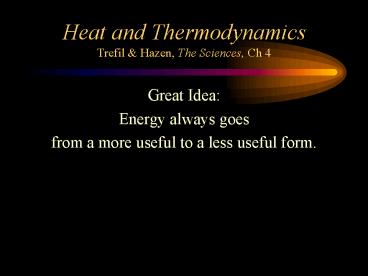Heat and Thermodynamics Trefil - PowerPoint PPT Presentation
1 / 34
Title:
Heat and Thermodynamics Trefil
Description:
Example: At Denver, water boils at 95oC instead of 100oC. Why? At higher pressure, boiling point is increased. Example: common 'pressure cooker' ... – PowerPoint PPT presentation
Number of Views:94
Avg rating:3.0/5.0
Title: Heat and Thermodynamics Trefil
1
Heat and ThermodynamicsTrefil Hazen, The
Sciences, Ch 4
- Great Idea
- Energy always goes
- from a more useful to a less useful form.
2
(No Transcript)
3
(No Transcript)
4
(No Transcript)
5
Heat Temperature
- thermal energy that flows from object of higher
temp. to object of lower temp.
- Measure of hotness, related to average kinetic
energy per molecule in an object.
6
30's hot 20's nice 10's cold zero's ice
7
Temperaturemeasure of the average kinetic energy
of a substance
- Celsius
- H2O bp 100
- H20 fp 0
- Fahrenheit
- H20 bp 212
- H20 fp 32
8
Absolute Zero (of temperature)
- No upper limit to temperature
- apply heat to matter and change phases solid
- liquid
- gas
- plasma
- Definite lower limit to temperature
- -273 C or 459 F
- absolute zero
- The point at which molecules lose all kinetic
energy
9
Weve never achieved absolute zero, but weve
come close!
- Temps of approx. 0.000001K have been reached,
but 0 K has never been reached
10
How do we know absolute zero exists?
- Gases expand when heated, contract when cooled.
- Gases at constant pressure, each 1oC drop in temp
reduces volume by 1/273 - If a gas at 0oC were cooled to 273oC, it would
contract down to a volume of zero
11
(No Transcript)
12
Specific Heat Capacity
- A measure of the ability of a material to absorb
heat energy - The quantity of heat required to raise the temp
of 1 gram of that material by 1oC.
13
Specific Heats of Selected Substances
- Substance Sp Ht (J/g-oC)
- Water 4.18
- Aluminum 0.89
- Carbon 0.71
- Iron 0.45
- Mercury 0.14
14
Thermal Expansion
- All phases of matter tend to expand when heated
and contract when cooled. - Think of examples of the above phenomena to share
with your students. - Discuss examples and engineering applications
15
Thermal Expansion
16
(No Transcript)
17
role-play phase changes
- Melting
- Solid to Liquid
- Heat input increases molecular motion to the
point that molecular connections break
- Freezing
- Liquid to Solid
- Energy dissipates and motion decreases
18
Evaporation vs Condensation
- Dry off outside shower
- Liquid water evaporates off of your body
- Water on your body is warmed and evaporates from
liquid to vapor, gaining kinetic energy
- Mirror is steamed up
- Water vapor condenses on cooler glass
- Warm, moist air cools and condenses from vapor to
water, losing kinetic energy
19
Evaporation Sublimation
20
Figure 4-4 Convection. Heat is transferred by
the bulk motion of the water.
21
Boiling
- Evaporation that occurs beneath the surface of a
liquid - bubbles of vapor
- Depends on 2 factors
- Temperature
- Pressure
22
Pressure and boiling
- At lower atmospheric pressure, boiling point is
lowered - Example At Denver, water boils at 95oC instead
of 100oC. - Why?
- At higher pressure, boiling point is increased
- Example common pressure cooker
- Why use one of these?
23
Heat Transfer
- Conduction
- Convection
- Radiation
24
conduction
- The movement of heat by collision of vibrating
atoms
25
convection
- Transfer of heat by the physical motion of fluid.
- (Dense cooler fluids descend and displace warmer
rising fluids)
26
radiation
- Movement of heat by electromagnetic energy.
- (The only mechanism that does not require atoms
to facilitate the transfer.)
27
Thermodynamics(Gr) movement of heat
- Conduction movement of heat through solids by
atomic collisions - Convection heat transfer in a gas or liquid via
currents or bulk motion of the heated fluid - Radiation transfer of heat through air or space
as infrared waves
28
Thermodynamics
- The study of the movement of heat
- Also refers to the science of heat, energy, and
work
29
Laws of Thermodynamics
- I Conservation of Energy
- In an isolated system, the total amount of
energy, including heat, is conserved. - II Entropy or disorder
- Energy always goes from a more useful to a less
useful form.
30
EnergyTransformation
31
The tendency toward disorder or entropy
32
Obstructions to the 2nd Law make life possible.
- 2nd Law of Thermodynamics and evolution
33
In Trefil Hazens text
- Please read about trophic levels and the first
law of thermodynamics - Also see on the consequences of the second law of
thermodynamics
34
Review Questions from ch 4
- discussion questions 1, 2, 4, 6-9
- problems 1 6, p. 90.































